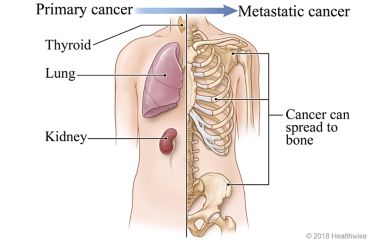
What is metastatic bone disease?
Metastatic bone disease is the spread of a malignant tumor from one part of the body to the bone.
A tumor is a growth of abnormal cells. When the growth is out of control and spreads or damages other cells, the tumor is called malignant. That means it's a type of cancer.
When cancer starts somewhere in the body—like in the prostate, breast, lungs, thyroid, or kidney—and spreads to another area, such as the bone, it is called metastatic. These tumors aren't the same as bone cancer. They are made of cancer cells from somewhere else in the body.
What are the symptoms?
The main symptom that cancer may have spread to your bones is pain or pressure in the bones. Metastatic cancer cells in your bone can weaken the bone and may cause it to break.
You may not have any symptoms. A doctor may find a tumor when taking X-rays or other images for another reason.
How is it diagnosed?
If you have symptoms that cancer has spread to your bones, you will get some tests.
- You may have one or more imaging tests to get a look at the tumor. These may include:
- X-rays.
- CT scan.
- MRI scan.
- PET scan.
- Bone scan.
- You may need blood tests and other lab work. This might include testing for substances in your body (biomarkers) that can help guide treatment.
- You may need a biopsy so a sample of the tumor can be looked at under a microscope.
- Doctors may also examine other parts of your body to see if the tumor has spread anywhere else.
How is it treated?
You may have already had treatments for the main type of cancer you have. These treatments will continue. They may help stop or slow the growth of the cancer in your bones.
You may need surgery if a bone tumor causes symptoms. Surgery may be done to make a bone more stable and to keep it from breaking. It can also help with pain.
Radiation therapy is used for some bone cancers. It uses high-energy rays, such as X-rays, to destroy cancer cells and shrink tumors in the body.
You may have chemotherapy (chemo). Chemo is medicine that destroys cancer cells.
You may also get medicine to protect your bones, treat any bone pain, and make you more comfortable.
Follow-up care is a key part of your treatment and safety. Be sure to make and go to all appointments, and call your doctor if you are having problems. It's also a good idea to know your test results and keep a list of the medicines you take.
Where can you learn more?
Go to http://www.healthwise.net/patientEd
Enter M125 in the search box to learn more about "Learning About Metastatic Bone Disease".
Current as of: October 25, 2024
Author: Ignite Healthwise, LLC Staff
Clinical Review Board
All Ignite Healthwise, LLC education is reviewed by a team that includes physicians, nurses, advanced practitioners, registered dieticians, and other healthcare professionals.

